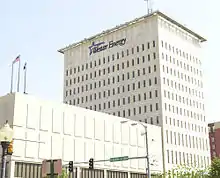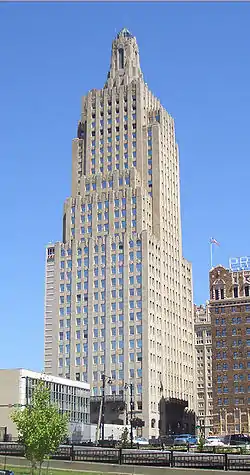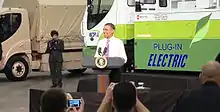Evergy
Evergy is an American investor-owned utility (IOU) with publicly traded stock that has its headquarters in Topeka, Kansas, and in Kansas City, Missouri. The company was formed from a merger of Westar Energy of Topeka and Great Plains Energy of Kansas City, Missouri, parent company of Kansas City Power & Light. Evergy is the largest electric company in Kansas, serving more than 1,000,000 residential, commercial and industrial customers[2] in the eastern half of the state. Evergy has a generating capacity of 16,000 megawatt electricity from its over 40 power plants in Kansas and Missouri. Evergy service territory covers 28,130 square miles (72,900 km2) in east Kansas and west Missouri. Evergy owns more than 13,700 miles (22,000 km) of transmission lines and about 52,000 miles of distribution lines.
 | |
| Type | Public |
|---|---|
| Industry | Electric utility |
| Predecessor | Company formed with mergers from Kansas Gas and Electric (KGE) & Kansas Power and Light (KPL) in 1992; Aquila (ILA) & Kansas City Power and Light (GXP) in 2008; Westar Energy (WR) and Kansas City Power and Light (GXP) in 2018 |
| Founded | 1882 |
| Headquarters | Topeka, Kansas, (admin. offices) Kansas City, Missouri, (corporate) |
Area served | Western half of Missouri and eastern half of Kansas 1.6 million customers |
Key people | Terry Bassham (CEO) |
| Products | Electricity generation Electric power transmission Electricity distribution |
| Revenue | |
Number of employees | 5,000 |
| Website | www.evergy.com &
www |

History of Westar Energy
Western Resources was the product of a 1992 merger between the two major electric companies in eastern Kansas, Kansas Gas and Electric (KG&E) of Wichita and Kansas Power and Light (KPL) of Topeka.
KG&E was founded in 1909 when the American Power and Light Company took over electric companies in Wichita, Pittsburg and Frontenac. Within a decade, it served over 48,000 people in 50 cities and towns. It also provided natural gas to several of the larger cities in its service territory.[3]
KPL was founded in 1924, and quickly expanded across northeastern Kansas. In 1983, it merged with The Gas Service Company, a natural gas utility serving customers in Kansas, Missouri, Nebraska and Oklahoma.[3]
In 1992, KPL merged with KG&E to become Western Resources, with KPL and KG&E as operating companies. The merger created one of the largest utilities in the Midwest, serving 560,000 electric customers and 1.06 million natural gas customers in three states. In 1996, Western Resources sold its natural gas business to ONEOK as Kansas Gas Service; this company is now part of ONE Gas. In return, Western Resources acquired a 45 percent stake in ONEOK; it sold this stake in 2003.[3]
In 2002, Western Resources officially changed its name to Westar Energy, and all of its subsidiaries began doing business under that name.[3]
History of Kansas City Power & Light


Kansas City Power and Light Company was an electric utility company serving the Kansas City metropolitan area. It was a wholly owned subsidiary of Great Plains Energy of which it was the biggest component. The company traces its roots to November 1881 when Joseph S. Chick obtained the exclusive rights to use the Thompson-Houston arc lighting system in the counties of Jackson, Missouri, and Wyandotte, Kansas, for $4,000. The following month, the initial franchise to establish an electric works in the City of Kansas, Mo., was granted to Lysander R. Moore and later assigned to Kawsmouth Electric Light Company. Construction was begun in February 1882 on a power plant on a tract of land at the southeast corner of 8th and Santa Fe Streets in the West Bottoms. Kawsmouth Electric Light Company built quickly and, on Saturday night, May 13, 1882, brought electric illumination to the first 13 customers on the west side of Main Street in the downtown district. In 1885 the company reincorporated as Kansas City Electric Light Company.
Weeks spun off the Edison Electric Light & Power Company to meet residential demand. An electric war ensued when in 1883 J. Ogden Armour, heir to the Armour Packing Company purchased the company on May 14, 1900, to power the Metropolitan Street Railway Company and Kansas City Electric Light Company. Under Armour the company bought competitors and built a new power plant in 1903, providing steam heat to downtown businesses. The company focused on the trolley company and in 1911 it went into receivership. In October 1917, the company spun off the trolley business (which still controlled some power plants) and emerged from bankruptcy as Kansas City Light & Power Company. In 1917 the company began construction on the Northeast Power station.
In June 1919, the company reincorporated again, as Kansas City Power and Light Company. After acquiring the Carroll County Electric Company on July 29, 1922, the reorganized company became Kansas City Power & Light Company, adopting the ampersand and corporate name that continues to this day. Armour sold his interest in 1923. Continental Gas & Electric Corporation purchased the controlling interest in 1924 and was part of United Light and Power until United dissolved in 1950. The Hawthorn Station, situated on the Missouri River, was started in 1948, and the first of two units were completed in 1951. Two other units followed and were fully operational by 1956. Kansas City Power became independent in 1950. It acquired Eastern Kansas Utilities in 1952. It was part of a consortium that built Wolf Creek Nuclear Generating Station in Burlington, Kansas.
On October 1, 2001 a holding company, Great Plains Energy Incorporated, was established based in Kansas City, Missouri that owned electric utility Kansas City Power and Light Company and Strategic Energy, LLC, an energy management company.
It acquired Aquila, Inc. in July, 2008.[4]
In 2014, it ranked #855 on the Fortune 1000 list.[5]
Merger of Kansas City Power & Light and Westar Energy
In 2016, Great Plains Energy and Westar announced merger plans,[6] but this proposed merger was rejected by Kansas Corporation Commission utility regulators as unfavorable to Kansas consumers.[7] A new merger plan with Great Plains was announced in 2017.[8] As of May 24, 2018, this merger has been approved by both the Missouri Public Service Commission and the Kansas Corporation Commission, with the combined company to be named Evergy.[9] KCP&L and Westar became the two operating companies of Evergy.
On October 7, 2019, the Westar and KCP&L brands were retired and the company adopted the Evergy brand across its entire service territory.
Generation portfolio
- Wolf Creek Nuclear Generating Station – Burlington, Kansas
- La Cygne Generating Station – La Cygne, Kansas
- Lawrence Energy Center – Lawrence, Kansas
- Abilene Energy Center – Abilene, Kansas
- Central Plains Wind Farm – Leoti, Kansas
- Emporia Energy Center – Emporia, Kansas
- Flat Ridge Wind Energy – Nashville, Kansas
- Gordon Evans Energy Center – Colwich, Kansas
- Hutchinson Energy Center – Hutchinson, Kansas
- Hawthorn Generating Station - Kansas City, Mo
- Iatan Generating Station - Weston, Mo
- Jeffrey Energy Center – St. Marys, Kansas
- Meridian Way Wind Farm – Concordia, Kansas
- Murray Gill Energy Center – Wichita, Kansas
- Neosho Energy Center (out of use since 2012) – Parsons, Kansas
- Rolling Meadows Landfill Gas to Energy Plant – Topeka, Kansas
- Spring Creek Energy Center – Logan County, Oklahoma
- State Line Combined Cycle Plant – Joplin, Missouri
- Tecumseh Energy Center – Tecumseh, Kansas
- Western Plains Wind Farm - Ford County, Kansas
Controversies
In 1999, Western Resources restated its consolidated financial statements for 1999, 1998 and 1997 and for each of the periods of 2000, related to the Westinghouse Security Systems (WSS) acquisition.[10]
On January 14, 2003, Westar Energy Inc was charged for transactions involved power sales from one Cleco Corporation affiliate to Westar and then back to another or the same Cleco affiliate,[11] and paid $30,000,000 USD for settlement.
On November 1, 2002, Westar Energy announced to restate results for its first and second quarter, to account for additional impairment at its Protection One Inc.(POI) unit.[12]
On March 25, 2004, Westar Energy said to restate its 2003 annual financial results, after realizing that it might have understated its cash flow from operations for the year.[13]
Awards
Evergy has been chosen as 2019 Healthiest 100 Workplaces in America by Springbuk[14]
In May 2019, Forbes named Evergy as one of America’s Best Top 500 Employers[15]
References
- https://www.macrotrends.net/stocks/charts/EVRG/evergy/revenue
- Evergy summary, Reuters, October 8, 2013
- http://www.westarenergy.com/wcm.nsf/content/company%20history
- "Aquila Acquisition" (PDF).
- "Great Plains Energy". Fortune. Retrieved March 19, 2015.
- Davis, Mark (May 31, 2016). "KCP&L parent agrees to buy Topeka-based Westar Energy". The Kansas City Star. Retrieved May 24, 2018.
- Vockrodt, Steve (April 19, 2017). "Regulators deny proposed $12.2 billion merger of KCP&L and Westar". The Kansas City Star. Retrieved May 24, 2018.
- Davis, Mark (November 17, 2018). "Shareholders vote on KCP&L parent's merger; regulators set timetable for review". The Kansas City Star. Retrieved May 24, 2018.
- Lefler, Dion (May 24, 2018). "Goodbye Westar Energy and KCP&L, hello Evergy; most Kansans to get new power company". The Wichita Eagle. Retrieved May 24, 2018.
- "Western Resources, Inc., Form 10-Q/A, Filing Date Feb 2, 2001". secdatabase.com. Retrieved May 15, 2018.
- "Westar Energy, Inc. : Common Stock and Western Resources Capital I Cumulative Quarterly Income". Archived from the original on December 10, 2008. Retrieved June 17, 2013.
- "Westar Energy to restate 2002 financial results".
- "Westar might have to restate 2003 results".
- "2019 Healthiest 100 Workplaces in America".
- "2019 Best Top 500 Employers".
